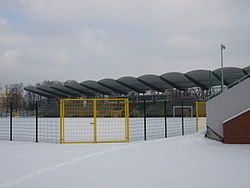Legnica railway station
Buildings and structures in LegnicaPolish railway station stubsRailway stations in Lower Silesian VoivodeshipRailway stations in Poland opened in 1844

Legnica (Polish: Legnica stacja kolejowa) is a railway station in the town of Legnica, Lower Silesia, Poland. Current building of the station has been opened for the public in 1927 and represents Art Deco style in architecture. It is one of few stations in Poland which has a large hall of steel-glass.
Excerpt from the Wikipedia article Legnica railway station (License: CC BY-SA 3.0, Authors, Images).Legnica railway station
Kolejowa, Legnica Przedmieście Głogowskie
Geographical coordinates (GPS) Address Nearby Places Show on map
Geographical coordinates (GPS)
| Latitude | Longitude |
|---|---|
| N 51.213888888889 ° | E 16.169166666667 ° |
Address
peron 2
Kolejowa
59-220 Legnica, Przedmieście Głogowskie
Lower Silesian Voivodeship, Poland
Open on Google Maps











